2010 Hyundai Sonata warning light
[x] Cancel search: warning lightPage 41 of 285
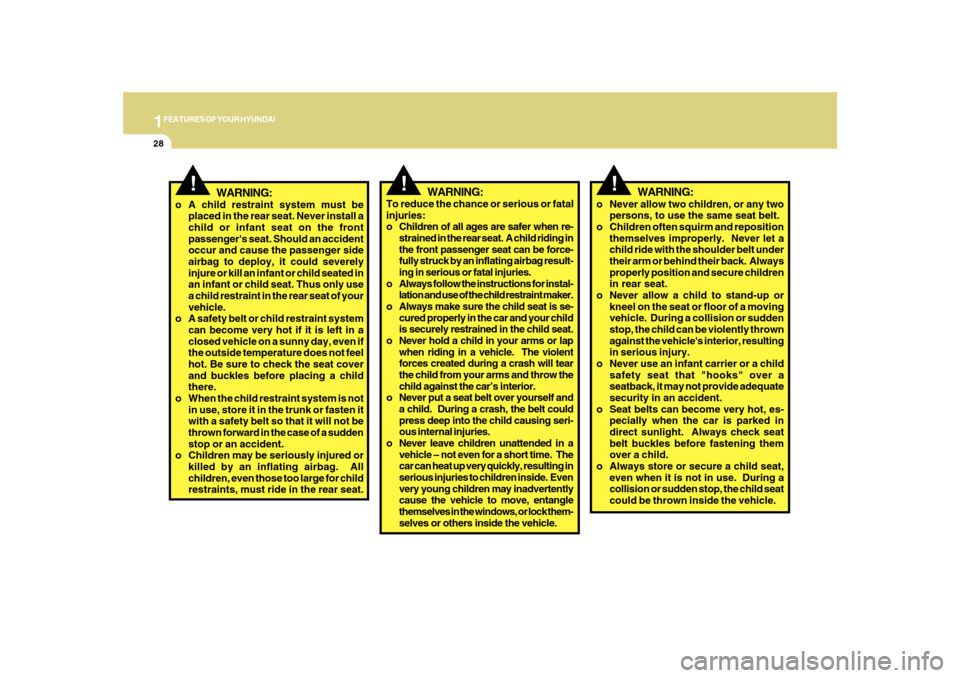
1FEATURES OF YOUR HYUNDAI28
!
WARNING:
o A child restraint system must be
placed in the rear seat. Never install a
child or infant seat on the front
passenger's seat. Should an accident
occur and cause the passenger side
airbag to deploy, it could severely
injure or kill an infant or child seated in
an infant or child seat. Thus only use
a child restraint in the rear seat of your
vehicle.
o A safety belt or child restraint system
can become very hot if it is left in a
closed vehicle on a sunny day, even if
the outside temperature does not feel
hot. Be sure to check the seat cover
and buckles before placing a child
there.
o When the child restraint system is not
in use, store it in the trunk or fasten it
with a safety belt so that it will not be
thrown forward in the case of a sudden
stop or an accident.
o Children may be seriously injured or
killed by an inflating airbag. All
children, even those too large for child
restraints, must ride in the rear seat.
!
WARNING:
To reduce the chance or serious or fatal
injuries:
o Children of all ages are safer when re-
strained in the rear seat. A child riding in
the front passenger seat can be force-
fully struck by an inflating airbag result-
ing in serious or fatal injuries.
o Always follow the instructions for instal-
lation and use of the child restraint maker.
o Always make sure the child seat is se-
cured properly in the car and your child
is securely restrained in the child seat.
o Never hold a child in your arms or lap
when riding in a vehicle. The violent
forces created during a crash will tear
the child from your arms and throw the
child against the car’s interior.
o Never put a seat belt over yourself and
a child. During a crash, the belt could
press deep into the child causing seri-
ous internal injuries.
o Never leave children unattended in a
vehicle – not even for a short time. The
car can heat up very quickly, resulting in
serious injuries to children inside. Even
very young children may inadvertently
cause the vehicle to move, entangle
themselves in the windows, or lock them-
selves or others inside the vehicle.o Never allow two children, or any two
persons, to use the same seat belt.
o Children often squirm and reposition
themselves improperly. Never let a
child ride with the shoulder belt under
their arm or behind their back. Always
properly position and secure children
in rear seat.
o Never allow a child to stand-up or
kneel on the seat or floor of a moving
vehicle. During a collision or sudden
stop, the child can be violently thrown
against the vehicle's interior, resulting
in serious injury.
o Never use an infant carrier or a child
safety seat that "hooks" over a
seatback, it may not provide adequate
security in an accident.
o Seat belts can become very hot, es-
pecially when the car is parked in
direct sunlight. Always check seat
belt buckles before fastening them
over a child.
o Always store or secure a child seat,
even when it is not in use. During a
collision or sudden stop, the child seat
could be thrown inside the vehicle.
!
WARNING:
Page 46 of 285
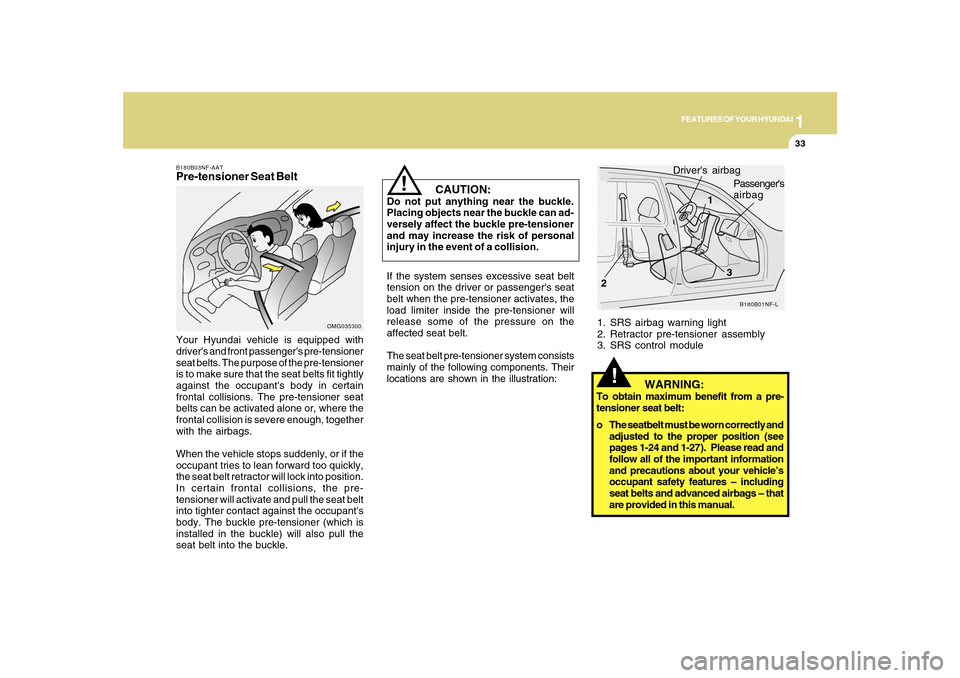
1
FEATURES OF YOUR HYUNDAI
33
!
1. SRS airbag warning light
2. Retractor pre-tensioner assembly
3. SRS control module
B180B01NF-L
1
23 Driver's airbag
Passenger's
airbag
WARNING:
To obtain maximum benefit from a pre-
tensioner seat belt:
o The seatbelt must be worn correctly and
adjusted to the proper position (see
pages 1-24 and 1-27). Please read and
follow all of the important information
and precautions about your vehicle’s
occupant safety features – including
seat belts and advanced airbags – that
are provided in this manual.
!
CAUTION:
Do not put anything near the buckle.
Placing objects near the buckle can ad-
versely affect the buckle pre-tensioner
and may increase the risk of personal
injury in the event of a collision.
If the system senses excessive seat belt
tension on the driver or passenger's seat
belt when the pre-tensioner activates, the
load limiter inside the pre-tensioner will
release some of the pressure on the
affected seat belt.
The seat belt pre-tensioner system consists
mainly of the following components. Their
locations are shown in the illustration:
B180B03NF-AATPre-tensioner Seat BeltYour Hyundai vehicle is equipped with
driver's and front passenger's pre-tensioner
seat belts. The purpose of the pre-tensioner
is to make sure that the seat belts fit tightly
against the occupant's body in certain
frontal collisions. The pre-tensioner seat
belts can be activated alone or, where the
frontal collision is severe enough, together
with the airbags.
When the vehicle stops suddenly, or if the
occupant tries to lean forward too quickly,
the seat belt retractor will lock into position.
In certain frontal collisions, the pre-
tensioner will activate and pull the seat belt
into tighter contact against the occupant's
body. The buckle pre-tensioner (which is
installed in the buckle) will also pull the
seat belt into the buckle.
OMG035300
Page 47 of 285
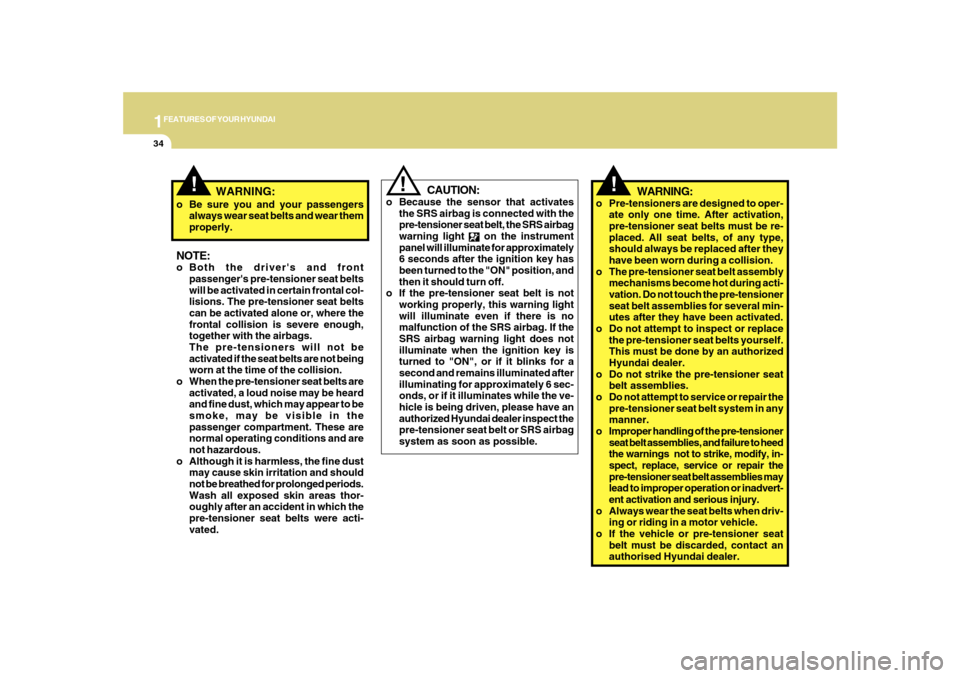
1FEATURES OF YOUR HYUNDAI34
!
o Be sure you and your passengers
always wear seat belts and wear them
properly.NOTE:o Both the driver's and front
passenger's pre-tensioner seat belts
will be activated in certain frontal col-
lisions. The pre-tensioner seat belts
can be activated alone or, where the
frontal collision is severe enough,
together with the airbags.
The pre-tensioners will not be
activated if the seat belts are not being
worn at the time of the collision.
o When the pre-tensioner seat belts are
activated, a loud noise may be heard
and fine dust, which may appear to be
smoke, may be visible in the
passenger compartment. These are
normal operating conditions and are
not hazardous.
o Although it is harmless, the fine dust
may cause skin irritation and should
not be breathed for prolonged periods.
Wash all exposed skin areas thor-
oughly after an accident in which the
pre-tensioner seat belts were acti-
vated.
WARNING:
!
CAUTION:
o Because the sensor that activates
the SRS airbag is connected with the
pre-tensioner seat belt, the SRS airbag
warning light
on the instrument
panel will illuminate for approximately
6 seconds after the ignition key has
been turned to the "ON" position, and
then it should turn off.
o If the pre-tensioner seat belt is not
working properly, this warning light
will illuminate even if there is no
malfunction of the SRS airbag. If the
SRS airbag warning light does not
illuminate when the ignition key is
turned to "ON", or if it blinks for a
second and remains illuminated after
illuminating for approximately 6 sec-
onds, or if it illuminates while the ve-
hicle is being driven, please have an
authorized Hyundai dealer inspect the
pre-tensioner seat belt or SRS airbag
system as soon as possible.
!
WARNING:
o Pre-tensioners are designed to oper-
ate only one time. After activation,
pre-tensioner seat belts must be re-
placed. All seat belts, of any type,
should always be replaced after they
have been worn during a collision.
o The pre-tensioner seat belt assembly
mechanisms become hot during acti-
vation. Do not touch the pre-tensioner
seat belt assemblies for several min-
utes after they have been activated.
o Do not attempt to inspect or replace
the pre-tensioner seat belts yourself.
This must be done by an authorized
Hyundai dealer.
o Do not strike the pre-tensioner seat
belt assemblies.
o Do not attempt to service or repair the
pre-tensioner seat belt system in any
manner.
o Improper handling of the pre-tensioner
seat belt assemblies, and failure to heed
the warnings not to strike, modify, in-
spect, replace, service or repair the
pre-tensioner seat belt assemblies may
lead to improper operation or inadvert-
ent activation and serious injury.
o Always wear the seat belts when driv-
ing or riding in a motor vehicle.
o If the vehicle or pre-tensioner seat
belt must be discarded, contact an
authorised Hyundai dealer.
Page 50 of 285
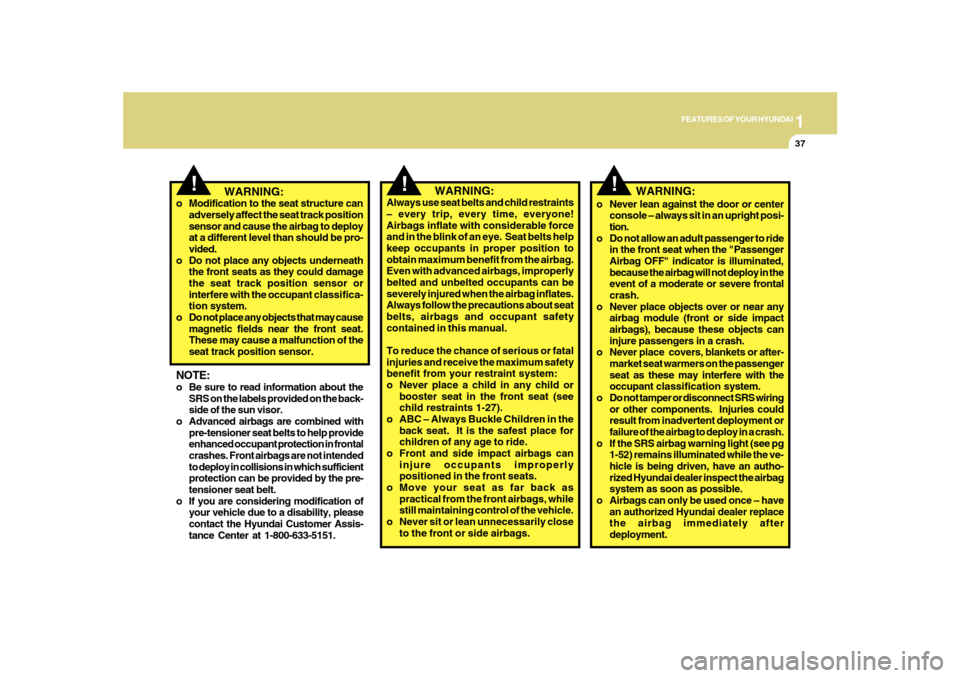
1
FEATURES OF YOUR HYUNDAI
37
!
!
WARNING:
Always use seat belts and child restraints
– every trip, every time, everyone!
Airbags inflate with considerable force
and in the blink of an eye. Seat belts help
keep occupants in proper position to
obtain maximum benefit from the airbag.
Even with advanced airbags, improperly
belted and unbelted occupants can be
severely injured when the airbag inflates.
Always follow the precautions about seat
belts, airbags and occupant safety
contained in this manual.
To reduce the chance of serious or fatal
injuries and receive the maximum safety
benefit from your restraint system:
o Never place a child in any child or
booster seat in the front seat (see
child restraints 1-27).
o ABC – Always Buckle Children in the
back seat. It is the safest place for
children of any age to ride.
o Front and side impact airbags can
injure occupants improperly
positioned in the front seats.
o Move your seat as far back as
practical from the front airbags, while
still maintaining control of the vehicle.
o Never sit or lean unnecessarily close
to the front or side airbags.
!
WARNING:
o Modification to the seat structure can
adversely affect the seat track position
sensor and cause the airbag to deploy
at a different level than should be pro-
vided.
o Do not place any objects underneath
the front seats as they could damage
the seat track position sensor or
interfere with the occupant classifica-
tion system.
o Do not place any objects that may cause
magnetic fields near the front seat.
These may cause a malfunction of the
seat track position sensor.NOTE:o Be sure to read information about the
SRS on the labels provided on the back-
side of the sun visor.
o Advanced airbags are combined with
pre-tensioner seat belts to help provide
enhanced occupant protection in frontal
crashes. Front airbags are not intended
to deploy in collisions in which sufficient
protection can be provided by the pre-
tensioner seat belt.
o If you are considering modification of
your vehicle due to a disability, please
contact the Hyundai Customer Assis-
tance Center at 1-800-633-5151.o Never lean against the door or center
console – always sit in an upright posi-
tion.
o Do not allow an adult passenger to ride
in the front seat when the "Passenger
Airbag OFF" indicator is illuminated,
because the airbag will not deploy in the
event of a moderate or severe frontal
crash.
o Never place objects over or near any
airbag module (front or side impact
airbags), because these objects can
injure passengers in a crash.
o Never place covers, blankets or after-
market seat warmers on the passenger
seat as these may interfere with the
occupant classification system.
o Do not tamper or disconnect SRS wiring
or other components. Injuries could
result from inadvertent deployment or
failure of the airbag to deploy in a crash.
o If the SRS airbag warning light (see pg
1-52) remains illuminated while the ve-
hicle is being driven, have an autho-
rized Hyundai dealer inspect the airbag
system as soon as possible.
o Airbags can only be used once – have
an authorized Hyundai dealer replace
the airbag immediately after
deployment.
WARNING:
Page 52 of 285

1
FEATURES OF YOUR HYUNDAI
39
12. Side Impact Airbag Module
13. Curtain Airbag Module
The SRSCM continually monitors all
elements while the ignition is "ON" to
determine if a frontal or near-frontal impact
is severe enough to require airbag
deployment or pre-tensioner seat belt
deployment.
The SRS airbag warning light on the in-
strument panel will illuminate for about 6
seconds after the ignition key is turned to
the "ON" position or after the engine is
started, after which the airbag warning
light should go out.
!
WARNING:
o Sitting improperly or out of position
can result in serious or fatal injury in
a crash. All occupants should sit
upright with the seat back in an upright
position, centered on the seat cushion
with their seat belt on, legs comfortably
extended and their feet on the floor
until the vehicle is parked and the
ignition key is removed.
o The SRS airbag system must deploy
very rapidly to provide protection in a
crash. If an occupant is out of position
because of not wearing a seat belt, the
airbag may forcefully contact the oc-
cupant causing serious or fatal
injuries.
B240B03NF-AATSRS Components and FunctionsThe SRS consists of the following compo-
nents:
1. Front Impact Sensor
2. "PASSENGER AIR BAG OFF" Indicator
(Front passenger's seat only)
3. SRS air bag warning light
4. Knee Bolster
5. Passenger's Airbag Module
6. Driver's Airbag Module
7. SRS Control Module (SRSCM)
8. Occupant Classification System
(Front passenger's seat only)
9. Driver's Seat Track Position Sensor
10. Side Impact Sensor
11. Retractor Pre-tensioner Assemblies
B240B01NF-B
B240B01L
Page 54 of 285
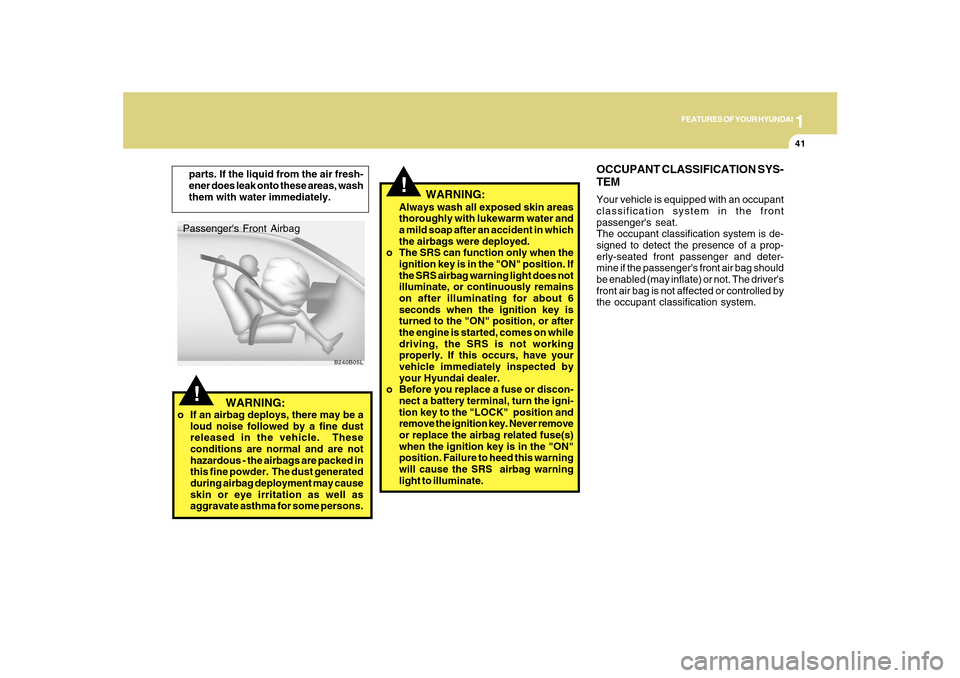
1
FEATURES OF YOUR HYUNDAI
41
!Passenger's Front Airbag
B240B05L
!Always wash all exposed skin areas
thoroughly with lukewarm water and
a mild soap after an accident in which
the airbags were deployed.
o The SRS can function only when the
ignition key is in the "ON" position. If
the SRS airbag warning light does not
illuminate, or continuously remains
on after illuminating for about 6
seconds when the ignition key is
turned to the "ON" position, or after
the engine is started, comes on while
driving, the SRS is not working
properly. If this occurs, have your
vehicle immediately inspected by
your Hyundai dealer.
o Before you replace a fuse or discon-
nect a battery terminal, turn the igni-
tion key to the "LOCK" position and
remove the ignition key. Never remove
or replace the airbag related fuse(s)
when the ignition key is in the "ON"
position. Failure to heed this warning
will cause the SRS airbag warning
light to illuminate. parts. If the liquid from the air fresh-
ener does leak onto these areas, wash
them with water immediately.
WARNING:
o If an airbag deploys, there may be a
loud noise followed by a fine dust
released in the vehicle. These
conditions are normal and are not
hazardous - the airbags are packed in
this fine powder. The dust generated
during airbag deployment may cause
skin or eye irritation as well as
aggravate asthma for some persons.
WARNING:OCCUPANT CLASSIFICATION SYS-
TEM
Your vehicle is equipped with an occupant
classification system in the front
passenger's seat.
The occupant classification system is de-
signed to detect the presence of a prop-
erly-seated front passenger and deter-
mine if the passenger's front air bag should
be enabled (may inflate) or not. The driver's
front air bag is not affected or controlled by
the occupant classification system.
Page 55 of 285

1FEATURES OF YOUR HYUNDAI42
B990A04NF-AATMain components of occupant clas-
sification systemo A detection device located within the
front passenger seat cushion.
o Electronic system to determine whether
passenger air bag systems (both front
and side) should be activated or deac-
tivated.
o A warning light located on the instru-
ment panel which illuminates the words
"PASSENGER AIR BAG OFF" indicat-
ing the front passenger air bag system
is deactivated.
o The instrument panel air bag warning
light is interconnected with the occu-
pant classification system.If the front passenger seat is occupied by
a person that the system determines to be
of adult size, and he/she sits properly (sit-
ting upright with the seatback in an upright
position, centered on the seat cushion with
their seat belt on, legs comfortably ex-
tended and their feet on the floor), the
"PASSENGER AIR BAG OFF" indicator
will be turned off and the front passenger's
air bag will be able to inflate, if necessary,
in frontal crashes.
You will find the "PASSENGER AIR BAG
OFF" indicator on the center facia panel.
This system detects the conditions 1~4 in
the following table and activates or
deactivates the front passenger air bag
based on these conditions.
ONF038024N
Always be sure that you and all vehicle
occupants are seated and restrained prop-
erly (sitting upright with the seat in an
upright position, centered on the seat cush-
ion, with the person’s legs comfortably
extended, feet on the floor, and wearing
the safety belt properly) for the most effec-
tive protection by the air bag and the safety
belt.
o The OCS (Occupant Classification Sys-
tem) may not function properly if the
passenger takes actions which can
defeat the detection system. These in-
clude:
(1) Failing to sit in an upright position.
(2) Leaning against the door or center
console.
(3) Sitting towards the sides or the front
of the seat.
(4) Putting legs on the dashboard or
resting them on other locations which
reduce the passenger weight on the
front seat.
(5) Improperly wearing the safety belt.
(6) Reclining the seat back.
Page 56 of 285
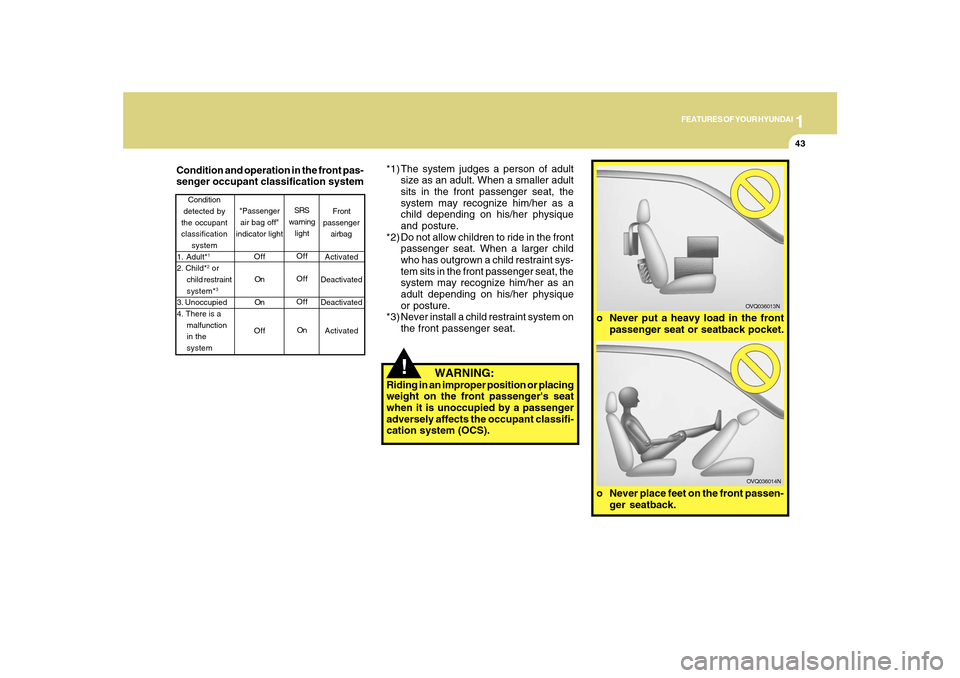
1
FEATURES OF YOUR HYUNDAI
43
!
Condition and operation in the front pas-
senger occupant classification system
WARNING:
Riding in an improper position or placing
weight on the front passenger's seat
when it is unoccupied by a passenger
adversely affects the occupant classifi-
cation system (OCS).
o Never place feet on the front passen-
ger seatback.
OVQ036014N
o Never put a heavy load in the front
passenger seat or seatback pocket.
OVQ036013N
Front
passenger
airbag
Activated
Deactivated
Deactivated
Activated Condition
detected by
the occupant
classification
system
1. Adult*
1
2. Child*
2 or
child restraint
system*3
3. Unoccupied
4. There is a
malfunction
in the
systemSRS
warning
light
Off
Off
Off
On
"Passenger
air bag off"
indicator light
Off
On
On
Off
*1) The system judges a person of adult
size as an adult. When a smaller adult
sits in the front passenger seat, the
system may recognize him/her as a
child depending on his/her physique
and posture.
*2) Do not allow children to ride in the front
passenger seat. When a larger child
who has outgrown a child restraint sys-
tem sits in the front passenger seat, the
system may recognize him/her as an
adult depending on his/her physique
or posture.
*3) Never install a child restraint system on
the front passenger seat.